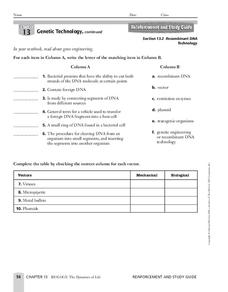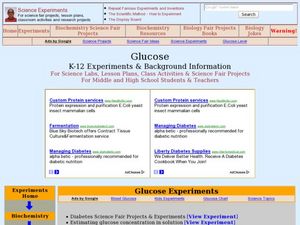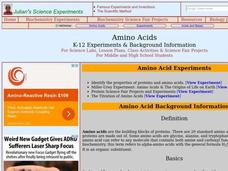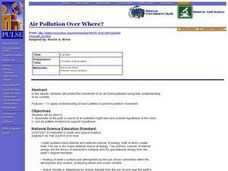Curated OER
Plankton / Phytoplankton
Students discuss the importance of plankton in the ocean ecosystem. In this biology activity, students identify the different types plankton by observing them under the microscope. They explain how plankton population affect global climate.
Curated OER
Genetic Technology
In this genetic learning exercise, students will match 6 terms associated with gene engineering to their correct definition. Then students will complete a table indicating if the vector is mechanical or biological. Finally, students will...
Curated OER
Elements of Life
Students discover they are made of elements in activities based on comparing the human body to the periodic table. In this science lesson students are engaged with 3 hands on basic chemistry activities. The students end the lesson by...
Curated OER
The Physical Behavior of Matter
Students distinguish between three phases of matter: solid, liquid and gas, on the molecular level. They compare and predict the relative compressibility of the three phases of matter through journal writings and drawings.
Curated OER
Glucose
Students conduct various experiments on glucose. In this biology instructional activity, students differentiate the process of diffusion and osmosis. They test different foods for the presence of glucose and starch.
Curated OER
Putting on Mass: Just how do Trees grow?
Learners articulate an explanation of photosynthesis. They identify problems they have with comprehension of how a plant gains mass. Students describe a historical experiment.
Curated OER
Investigating the Uses of Backyard Bacteria
Students discover that the answers to some of society's waste and clean-up problems may be no further than the soil beneath their feet. They perform a Gram stain on the colonies to determine some of their characteristics.
Curated OER
Food Safety Unit Exam 1
Students complete seventeen question test about food safety which includes matching vocabulary terms, short answer questions and fill in the blank questions. Test is part of the Food Safety Unit produced by the College of Agricultural...
Curated OER
Amino Acids
Students explore what amino acids are, their history and how they are used in technology. In this protein lesson plan students identify the properties of proteins and amino acids.
Curated OER
DNA
Students explore the basics of DNA and its history. In this DNA lesson students extract DNA from fruits and understand how it is used in forensics.
Curated OER
The Plasma Membrane
In this plasma membrane instructional activity, students will explore how cells are able to maintain homeostasis and the function of the plasma membrane. This instructional activity has 6 fill in the blank and 7 true or false questions.
Curated OER
Cell Structure and Function
In this cells worksheet, students review the different types of cells. Students identify the organelles found in an animal cell and determine the function of these organelles. This worksheet has 14 matching, 6 fill in the blank, and 5...
Curated OER
Fossils
In this fossil activity, students match six terms with their definitions about types of fossils and they circle the proper term to make nine statements true about preservation of fossils.
Curated OER
Fossils
In this fossils worksheet, students review the different types of fossils including index and trace fossils. This worksheet has 6 matching and 9 true or false questions.
Curated OER
Chloroplasts
Students study chloroplasts, their structure and evolution. In this photosynthesis lesson students experiment with polarized light and the production of chlorophyll.
Curated OER
A View of the Cell
For this cell worksheet, students will match 13 vocabulary words relating to cells to the correct definition. The cell vocabulary words cover all the parts of the cell plus eukaryotes, and prokaryotes.
Curated OER
DNA and Genes
In this DNA worksheet students will label the 6 parts that make up DNA and review the process of replication of DNA. This worksheet has 6 matching and 5 fill in the blank questions.
Curated OER
Necessary Nitrogen
Students view a video that presents the biogeochemical cycle of nitrogen. They compare types of soils and consider how different fertilizers affect soil composition.
Curated OER
Observing Osmosis in a Chicken Egg
Tenth graders develop a hypothesis and explain what they observed on an activity. For this investigative lesson students observe osmosis and report their data using a graph.
Curated OER
Thermoset Polymers
Students complete a lab activity with polymers to allow them to better understand how to make "observations". In this science lesson students make measurements and collect data.
Curated OER
Autumn
Students examine the cycle of nutrients in a forest. They research the concepts of decomposing and recycling within a forest.
Curated OER
Air Pollution Over Where?
Students predict the movement of an air borne pollutant using their understanding of air currents. They determine which governments and/or communities should be contacted to be forewarned. They also explore the properties of their...
Curated OER
Polymerase Chain Reaction and DNA Profiling
Students examine DNA fingerprinting and polymerase chain reaction and how they are used in everyday life and for criminal investigations. They discover how these techniques can also be used to answer ecological and evolutionary questions.
























